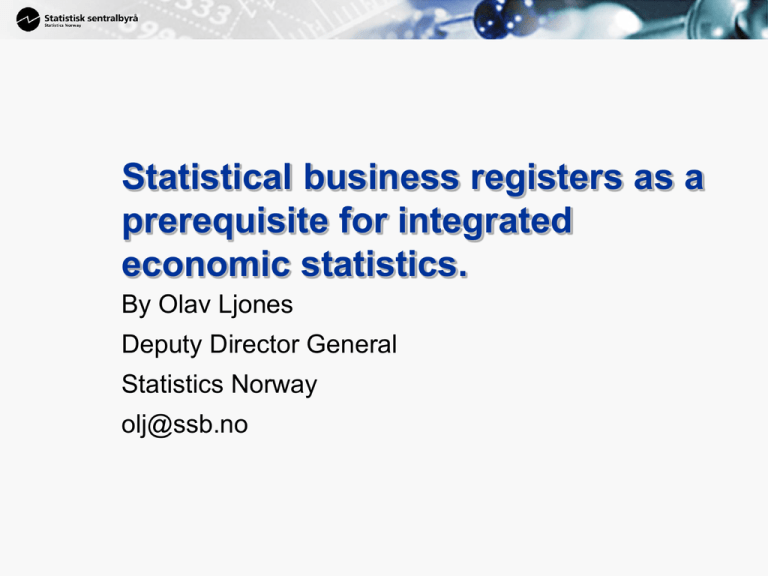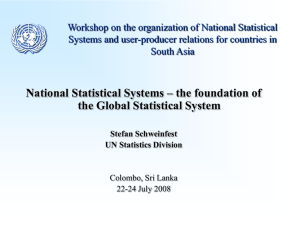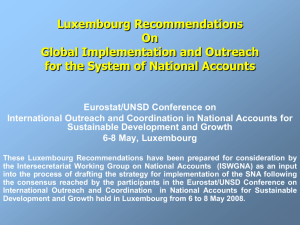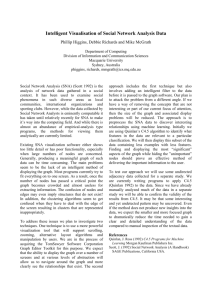Integrated economic statistics
advertisement

1 Statistical business registers as a prerequisite for integrated economic statistics. By Olav Ljones Deputy Director General Statistics Norway olj@ssb.no Introduction ”A statistical agency must have a business register” UN Handbook (2003) page 108. • • The content of my presentation: Why - the importance of Business Registers for integrated economic statistics – National Accounts the ultimate integration of economic statistics – What is new in SNA 2008 – and with relevance for Business registers – Integrated production of official statistics – no future for the stove pipe solution • How – to build and operate a modern business register – The statistical unit and identifier – The use of administrative data – National and global challenges The SNA 2008 Integrated economic statistics • Official statistics should be consistent and coherent. Relevant and user oriented. The production should be efficient and with concern for the response burden. • References: – Discussion of integrated economic statistics at UN Statistical Commission 2011. Document – in English and Russian. – English: http://unstats.un.org/unsd/statcom/doc11/2011-10IntegratedEcoStats-E.pdf – Russian: http://unstats.un.org/unsd/statcom/doc11/2011-10IntegratedEcoStats-R.pdf – The 2010 version of the report of the Expert Group ( only in English) – http://unstats.un.org/unsd/nationalaccount/ies/draftGuidelines.pdf Integrated economic statistics 2 • Economic policy • will benefit from integrated economic statistics. Data consistency and coherence is important. National Accounts and SNA as the integrating framework. Various strategies are possible but centralized data collections systems and common business registers and common source data will be important elements. Consistent classification of units through the statistical system will be beneficial. What is “economic statistics” – Statistics for economic units - Business statistics ( yearly and short term statistics) – Statistics on economic variables ( wages and income) – National accounts. Integrated economic statistics 3 • Integration, consistency and coherence is about: – Common definitions of statistical units and sampling frame (population of units) – Common definitions of concepts and variables, Common classification. – Common methods for quality control, estimation and tabulation including e.g. methods for seasonal adjustments – Integrated IT solutions – integrated production of official statistics • One observation e.g from Norway is that for basic economic statistics (primary statistics) some definitions of concepts may be sector dependent and not fully consistent. This is acceptable. • The complete integration is achieved through the National Accounts. For this integration it is important to have consistent and common Business register with common classification of activity and status. National Accounts and SNA 2008 • National Accounts is about both national and international coordination of statistics. The ambitions and international solutions is a strength but also a challenge. International comparability gives value added to official statistics but may also hide national specialities. • In general NA need full coverage of all economic units and double accounting is not to be accepted. • The easy way to define economic units for use in Business register (BR) is to focus on legal units which in practice will be close to enterprise. SNA will ask for establishment - (LKAU) Local kind of activity unit. Supplementary procedures is necessary to include LKAU in statistics. • Too high international ambitions may create national problems. A challenge is the implementation of SNA 2008 and the result may be lack of international comparability Business Registers and SNA • Globalisation is the big challenge for official statistics and • • National Accounts We need data on international relations (national units with international links and international units with national link) . This is a challenge for BR Changes in SNA 2008? – Definitions of ownership – New and more demanding content on international units and relations – Some changes in statistical units and institutional sectoring (e,g, Some on: Holding offices and Head office. On financial sectors. More on informal sector) – Some changes in production boundary, e.g on Research and development – a separate establishment for R&D? Business registers – how to build and operate • Relevant literature: – The importance and organisation in general : UN handbook ( 2003) http://unstats.un.org/unsd/pubs/gesgrid.asp?id=295 Based on European situation Eurostat have published Business registers. Recommendations manual 2010 edition: – http://epp.eurostat.ec.europa.eu/cache/ITY_OFFPUB/KS-32-10-216/EN/KS32-10-216-EN.PDF • Definition of statistical unit. – Legal unit – is a part of – enterprise (institutional unit) – carries on activities in its – local unit (establishment). – Administrative and statistical units, identifiers and registers. The Norwegian solution from 1995 is to have close links and close cooperation (exchange of data) between the administrative and statistical operations. Beneficial for business units, administration and statistics. The role of independent official statistics has to be secured and respected. The family of registers – Norway as an example • The administrative registers see: http://www.brreg.no/english/ – The Central Coordinating Register for Legal Entities and The Register of Business enterprises are in close cooperation with the Statistical Business register in Statistics Norway. – The unique identifier – used all over both administration and statistics – IT solutions – Merging of data and storing of data • Linking of data – administrative data. For Statistics also link data that have been collected for statistical purposes. One way traffic to Statistics – no delivery of statistical micro data to administration • Benefit – reduced response burden , efficient and consistent government administration but also the finance market needs register data. • And not to forget integrated economic statistics. The Norwegian statistical model • • • • • • • • • • • • • • Strong control of all statistical units and sampling frame for all business surveys Common and central classifications (industry and institutional sector) Common collection and use of accounts data – tax accounts and other accounts Value added register/data and customs are integrated – id number Register data for employment and in the future also wages. Link employer and employee Geografical information Efficient sampling – stratification and coordination of response burden. High quality quarterly and yearly national accounts Consistent set of business surveys Integration with labour marked and income statistics Coordination of international relations – Balance of payment statistics Government statistics – electronic reporting and use of register data Integration of IT and production systems (under work) 11 Thank you







